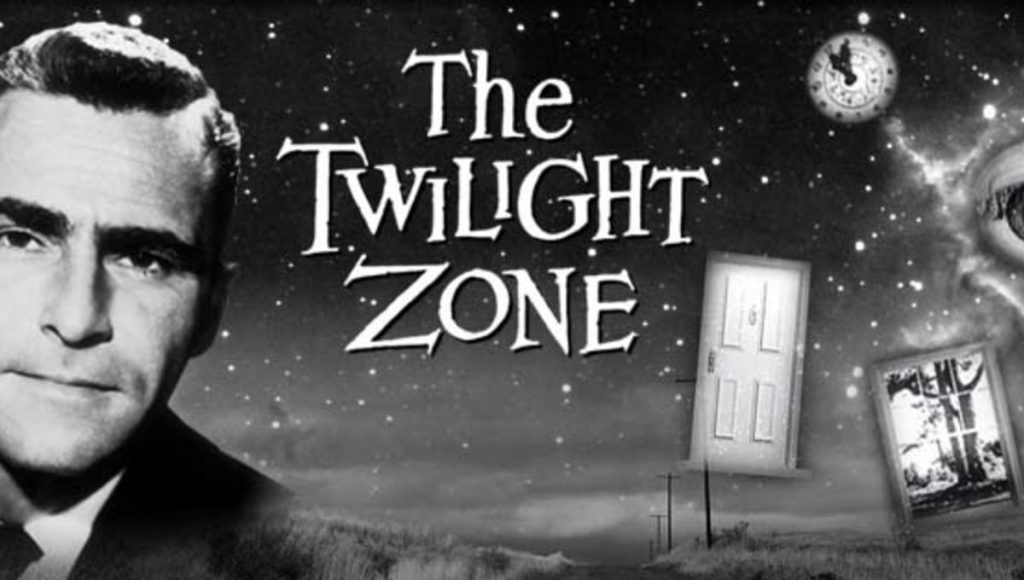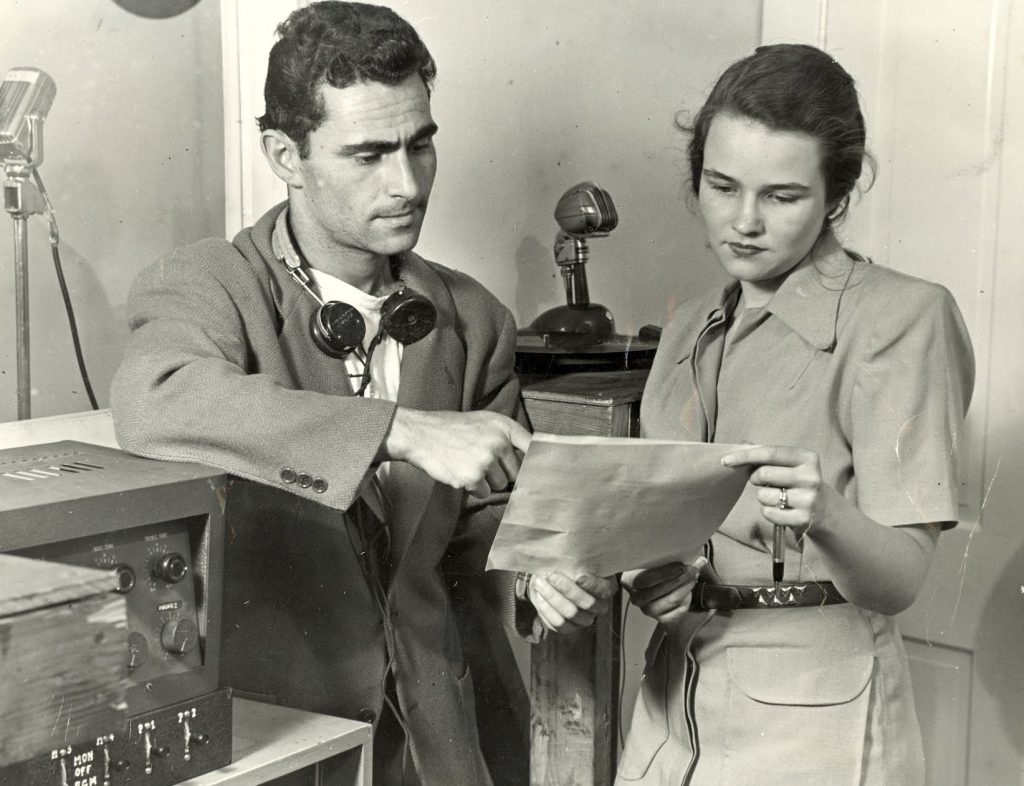
Though the Syfy Channel has traditionally been the home of the New Year and Independence Day Twilight Zone marathons, this year the Decades channel will be celebrating the 4th of July Weekend with “Rod, White, and Blue,” to commemorate creator Rod Serling on the 45th anniversary of his death, at age 50, on June 28, 1975.
https://www.youtube.com/embed/CYQrUc8VAD8
Serling was born on Christmas Day in 1924 in Syracuse, New York. He graduated from Antioch College in Yellow Springs, Ohio, after serving in the military. While at Antioch, he became manager of the college’s radio station, and also lived in Marion, working at radio station WMRN (you can read more about his time in Marion and the impression he made upon his co-workers here: https://tinyurl.com/y8esqluy ). He then moved his family to Cincinnati. It was there he began his professional writing career, writing first radio and then television scripts for WKRC. While freelancing, he continued to send scripts to publishers, receiving over 40 rejection slips. His wife Carol said he eventually became fed up and just quit, moving his family to Connecticut in 1953. His agent convinced him that if he really wanted a career in television he should move to New York, so in 1954 he packed up his wife and young children once again and moved to the city.
He quickly got work on Kraft Television Theater as well as several other TV productions, including continued work back at WKRC. He continued to develop a name for himself, and eventually got attention from executives at CBS. After a long process, The Twilight Zone was greenlit and premiered on October 2, 1959.
For this series, Serling fought hard to get and maintain creative control. He hired scriptwriters he respected, such as classic genre writers Richard Matheson, Ray Bradbury, and Charles Beaumont. In an interview, Serling said he hoped the show’s science fiction format would not be controversial with sponsors, network executives, or the general public, and should escape censorship.
Serling drew on his own experience for many episodes, frequently about boxing, military life, and airplane pilots. Carol Serling said his time in the military was traumatic and changed many of his worldviews, which made their way into his writing. The Twilight Zone incorporated his social views on racial relations, somewhat veiled in the science fiction and fantasy elements of the shows. His use of allegory was masterful and he was able to get a lot of controversial topics past censors, at a time when other shows were not even willing to try. Occasionally, though, the point was quite blunt, such as in the episode “I Am the Night—Color Me Black,” in which racism and hatred causes a dark cloud to form in the American South and spread across the world.
Many Twilight Zone stories reflected his views on gender roles, featuring quick-thinking, resilient women as well as shrewish, nagging wives. Cleveland native Burgess Meredith appears in four of the most famous episodes of the show, including “Time Enough at Last,” the chilling tale of a mild-mannered man who only wants to read his books in peace, and is horrified when his wish is granted. Another episode was based on Ohioan Ambrose Bierce’s “Occurrence at Owl Creek Bridge;” directed by Robert Enrico, it was submitted to the Academy Awards and won the Best Short Film award at the 1964 Oscars.
The Twilight Zone aired for five seasons (the first three presented as half-hour episodes, the fourth had hour-long episodes, and the fifth returned to the half-hour format). It won many television and drama awards and drew critical acclaim for Serling and his co-workers. Although it had loyal fans, The Twilight Zone had only moderate ratings and was twice canceled and revived. After five years and 156 episodes (92 written by Serling), he grew weary of the series. In 1964, he decided not to oppose its third and final cancellation.
Rod Serling continued to work in TV, creating another classic anthology series, Night Gallery, which ran from 1969-1973. He also consistently worked in radio, writing for The Zero Hour and Fantasy Park. Additionally, he often spoke at college campuses around the USA. He wrote screenplays for films, including the original version of the science fiction classic, The Planet of the Apes. He also taught week-long seminars in which students would watch and critique movies. In the political climate of the 1960s, he often felt a stronger connection to the older students in his evening classes.
Serling’s critique of high school student writing was a pivotal experience for writer J. Michael Straczynski, who science fiction and comic fans will know well as the long-time writer of Thor comics for Marvel and Superman for DC, as well as the creator of the influential television series Babylon 5 and Sense8. Later Serling taught at Ithaca College, from the late 1960s until his death in 1975. He was one of the first guest teachers at the Sherwood Oaks Experimental College in Hollywood, California. Audio recordings of his lectures there are included as bonus features on some Twilight Zone home video editions.

Rod and Carol Serling via John Hoke/Antiochiana, Antioch College
According to his wife, Serling often said that “the ultimate obscenity is not caring, not doing something about what you feel, not feeling! Just drawing back and drawing in, becoming narcissistic.” This philosophy can be seen in his writing. Some themes appear again and again, many of which are concerned with war and politics. Another common theme is equality among all people. He frequently spoke out against racism, social inequality, the Vietnam War, government oppression, and police brutality. In a speech delivered December 3, 1968 at Moorpark College, Moorpark, California, he said,
“I would rather have a son or daughter of mine march through the streets of Chicago protesting injustice—than I would siring a Chicago policeman who’ll club anyone who’ll get in his way—and that includes sixteen-year-olds, newspaper photographers, and senior citizens.” (December 4, 1968, excerpted from https://rodserling.com/rod-serling-rips-loyalty-oaths-the-vietnam-war-and-social-inequity/ )
Angered and mourning the death of Dr. Martin Luther King, Jr., he said:
“In his grave, we praise him for his decency – but when he walked amongst us, we responded with no decency of our own. When he suggested that all men should have a place in the sun – we put a special sanctity on the right of ownership and the privilege of prejudice by maintaining that to deny homes to Negroes was a democratic right. Now we acknowledge his compassion – but we exercised no compassion of our own. When he asked us to understand that men take to the streets out of anguish and hopelessness and a vision of that dream dying, we bought guns and speculated about roving agitators and subversive conspiracies and demanded law and order. We felt anger at the effects, but did little to acknowledge the causes. We extol all the virtues of the man – but we chose not to call them virtues before his death. And now, belatedly, we talk of this man’s worth – but the judgement comes late in the day as part of a eulogy when it should have been made a matter of record while he existed as a living force. If we are to lend credence to our mourning, there are acknowledgements that must be made now, albeit belatedly. We must act on the altogether proper assumption that Martin Luther King asked for nothing but that which was his due… He asked only for equality, and it is that which we denied him.” (Letter to The Los Angeles Times; April 8, 1968.)
A Town Has Turned to Dust, Serling’s 1958 made-for-TV film, received a positive review from the critic Jack Gould, who was known for being straightforward to the point of being harsh in his reviews. He called A Town Has Turned to Dust, “a raw, tough and at the same time deeply moving outcry against prejudice.” Set in a Southwestern town in a deep drought, it sees poverty and despair turn racial tensions deadly when the ineffectual sheriff is unable to stand against the town. A young Mexican boy is lynched, and the town as a whole is to blame. A second lynching is in the works after a series of events leads again to the town turning against the Mexicans. This time, the sheriff stands strong, and the first boy’s brother is saved, even as the town is not. “Mr. Serling incorporated his protest against prejudice in vivid dialogue and sound situations. He made his point that hate for a fellow being leads only to the ultimate destruction of the bigoted,” said Gould, in the New York Times.
Serling took his 1972 screenplay for the film, The Man, from the Irving Wallace novel of the same title. A black senator from New Hampshire and president pro tempore of the Senate, played by James Earl Jones, assumes the U.S. presidency by succession.
Sadly, Rod Serling passed away at the early age of 50, after suffering three heart attacks very quickly. His wife Carol survived him and continued to speak about her husband and his legacy for many years, until she also passed away a month before her 92nd birthday on January 9, 2020. Serling’s daughter Anne, born during the family’s time in Connecticut, wrote a stirring memoir about her father, As I Knew Him: My Dad, Rod Serling, in 2013, and has also continued to write and speak about her father’s legacy.
Serling is indelibly woven into modern popular culture because of the enduring popularity of The Twilight Zone. Even youth of today can hum the theme song, and the title itself is a synonym for all things unexplainable. It has lived on with a movie, graphic novels, many books (including Ohio film critic and Twilight Zone expert Mark Dawidziak’s Everything I Know I Learned in the Twilight Zone), albums, and even a ride at Disney World. It has also inspired a few TV reboots, including one that started on CBS All Access in 2019, produced by Jordan Peele, which has just started a second season. Serling’s widow, Carol, maintained that the cult status that now surrounds both her husband and his shows continues to be a surprise, “as I’m sure it would have been to him.” Carol, who was raised in Columbus, helped establish the Rod Serling Archives at Ithaca College in upstate New York. The collection includes scripts and screenplays, her husband’s six Emmy Awards, plus photos, films, and books from his personal collection. She also helped endow a Rod Serling Scholarship in Communications there.
The origins of Twilight Zone holiday marathons are themselves shrouded in a bit of mystery (you can read more about that here: https://www.denofgeek.com/tv/the-twilight-zone-marathon-a-history-of-a-holiday-tradition/ ). One thing is true: the show has a legacy that has evolved far beyond what Serling ever intended, resonating with viewers across generations for over sixty years. Whether this is your first time viewing the show or your one hundredth, there is always something new to discover, some underlying theme to Serling’s vision that continues to captivate audiences from year to year.
The “Rod, White and Blue” marathon begins at 12p ET | 9a PT on July 4 on Decades, and runs through the weekend. Check your local listings: https://www.decades.com/wheretowatch
